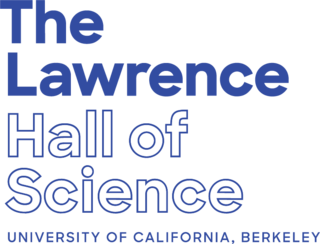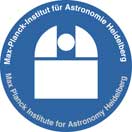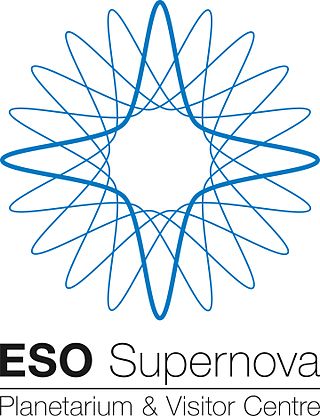
An astronomer is a scientist in the field of astronomy who focuses their studies on a specific question or field outside the scope of Earth. They observe astronomical objects such as stars, planets, moons, comets and galaxies – in either observational or theoretical astronomy. Examples of topics or fields astronomers study include planetary science, solar astronomy, the origin or evolution of stars, or the formation of galaxies. A related but distinct subject is physical cosmology, which studies the Universe as a whole.

The Lawrence Hall of Science is a public science center in Berkeley, California that offers hands-on science exhibits, designs curriculum, aids professional development, and offers after school science resources to students of all ages. The Lawrence was established in 1968 in honor of physicist Ernest Orlando Lawrence (1901–1958), the University of California's first Nobel laureate. The center is located in the hills above the University of California, Berkeley campus, less than a mile uphill from the University's Botanical Garden.

The Kopernik Observatory & Science Center (KOSC), is a public observatory in Vestal, New York opened to the public on 16 June 1974 by the Kopernik Society of Broome County to commemorate the 500th anniversary of the birth of the astronomer Nicolaus Copernicus in 1973. Its mission is to offer hands-on investigations and outreach programs for educating all ages about astronomy and science using advanced optical telescopes, computers and other tools. It is the first science laboratory facility in New York State designed for K-12 teachers, students and their families, and has been one of the best-sited and best equipped public observatories in the Northeast United States for nearly the last 40 years.
In the European Union education is at the responsibility of its Member States and their Ministries of education that they have; in such, the European Union institutions play only a supporting and overseeing role. According to Art. 165 of the Treaty on the Functioning of the European Union, the Community
shall contribute to the development of quality education by encouraging cooperation between Member States, through actions such as promoting the mobility of citizens, designing joint study programmes, establishing networks, exchanging information or teaching languages of the European Union. The Treaty also contains a commitment to promote life-long learning for all citizens of the Union.

The Max-Planck-Institut für Astronomie is a research institute of the Max Planck Society (MPG). It is located in Heidelberg, Baden-Württemberg, Germany near the top of the Königstuhl, adjacent to the historic Landessternwarte Heidelberg-Königstuhl astronomical observatory. The institute primarily conducts basic research in the natural sciences in the field of astronomy.

Pine Mountain Observatory (PMO) is an astronomical observatory owned and operated by University of Oregon Department of Physics. The facility is located 26 miles (42 km) southeast of Bend, Oregon (USA) in the Deschutes National Forest near the summit of Pine Mountain.

The International Year of Astronomy (IYA2009) was a year-long celebration of astronomy that took place in 2009 to coincide with the 400th anniversary of the first recorded astronomical observations with a telescope by Galileo Galilei and the publication of Johannes Kepler's Astronomia nova in the 17th century. The Year was declared by the 62nd General Assembly of the United Nations. A global scheme, laid out by the International Astronomical Union (IAU), was also endorsed by UNESCO, the UN body responsible for educational, scientific, and cultural matters.

Las Cumbres Observatory (LCO) is a network of astronomical observatories run by a non-profit private operating foundation directed by the technologist Wayne Rosing. Its offices are in Goleta, California. The telescopes are located at both northern and southern hemisphere sites distributed in longitude around the Earth. For some astronomical objects, the longitudinal spacing of telescopes allows continuous observations over 24 hours or longer. The operating network currently consists of two 2 meter telescopes, nine 1 meter telescopes, and seven 40 cm telescopes, placed at six astronomical observatories. The network operates as a single, integrated, observing facility, using a software scheduler that continuously optimizes the planned observing schedule of each individual telescope.

NASA's Education and Public Outreach (E/PO) group at Sonoma State University, founded in 1999, is a provider of educational materials for students, educators, scientists, and the public. Funded by NASA and the United States Department of Education, employees work together to create educational guides, fact sheets, worksheets, posters, games, and informational websites. Most of these educational materials are related to the four major missions that support the group: Fermi Gamma-ray Space Telescope, Swift Gamma-Ray Burst Mission, XMM-Newton, and NuSTAR.
The Faulkes Telescope Project (FTP) is supported by the Dill Faulkes Educational Trust. It provides access to 1,500 hours of observing time on two 2-metre class telescopes located in Hawaii and Australia. This time is dedicated to education and public outreach, mainly in the UK, but also for smaller, selected projects in Europe and the US.
The Bareket Observatory is an astronomical educational observatory owned and operated by the Bareket family. It is located east of the city of Maccabim, near Modiin.

The European Association for Astronomy Education or EAAE is a non-profit European organization for the promotion of science education in general, and of astronomy in particular.
The Lifelong Learning Programme 2007–2013 in Finland consisted of the Finnish participation in the Lifelong Learning Programme 2007–2013 of the European Union.
The Comenius programme is a European Union educational project. It concerns school-level education, and is part of the EU's Erasmus + 2014-2020 Programme. It aims "to help young people and educational staff better understand the range of European cultures, languages and values".

The ESO Supernova Planetarium & Visitor Centre is an astronomy centre located at the site of the European Southern Observatory (ESO) Headquarters in Garching bei München. It offers exhibitions, guided tours and planetarium shows that feature observations made by the telescopes of the European Southern Observatory.
The Global Science Opera (GSO) is a creative education initiative that combines science, art, technology, and education in a global network of scientists, art and education institutions and projects. Using digital interaction, schools, universities and art and institutions from over 30 participating countries perform and live-stream Global Science Opera performances. One team in each participating country is invited to develop a two-minute scene for the opera, with all the scenes being performed together on a designated date as a continuous, real-time event that viewers can watch online.
The Nepal Astronomical Society (NASO) is a Nepali learning community of professional astronomers and other interested individuals headquartered in Kathmandu. Its primary objective is to promote the advancement of astronomy, astrophysics and other closely related branches of science through various outreach and educational activities, while the secondary purpose includes enhancing the research in astronomy and astrophysics and providing a helpful and knowledgeable platform for members through its various activities. Its current mission is to enhance and share the knowledge of astronomy, astrophysics and humanity's scientific understanding of the universe.
Katherine Gudrun Isaak is a British astrophysicist and the Project Scientist for the European Space Agency Characterising Exoplanet Satellite mission (CHEOPS). She is based at European Space Research and Technology Centre.

The 40-foot radio telescope at Green Bank Observatory in the U.S. state of West Virginia was constructed in 1961, and started observing a selection of variable radio sources in the same year, completing its observations in 1968. It became the first automated telescope in 1962. It was subsequently used during summer schools, and in 1987 it was repurposed as an educational telescope, as well as continuing to observe radio sources. In 2021 the telescope celebrated its sixtieth anniversary, having been in continuous use since its 1987 restoration, and used by more than 1,500 students.










